How to Track Media Coverage for Free
Free media monitoring is always going to be flawed, but I would argue that many of the paid services are flawed as well.
Meltwater will pick up different mentions than Muck Rack. Prowly will pick up different mentions than Critical Mention. It’s just the way it is.
If you’re on a budget and your media-monitoring needs aren’t all that complex, you might find that free tools like Google Alerts and Talkwalker can get the job done.

They demand a little more from you than paid tools. You need to take care in setting things up. You won’t get tidy reports at the push of a button. But ultimately, free media-monitoring tools can find your brand mentions and whichever specific campaigns that you’re looking to track.
What more do you really need?
My favourite free alternatives are Google Alerts and Talkwalker. In this post, I’ll walk you through how to use both for media monitoring.
Google Alerts
Google introduced its Alerts feature in 2003 to help users stay on top of their topics of interest without having to perform manual searches.
Once you specify your search terms, it will send a roundup of new pages where those terms appear to your Gmail address.
Alerts doesn’t seem to get much love from Google’s product teams these days, so we haven’t seen improvements in functionality for a while. We don’t know what its future is, but for now, it still works for its core purpose. Here’s how you do it.
How to Set Up Google Alerts
Step 1: Go to google.com/alerts
Step 2: Enter your terms in the Search field at the top. It helps to know Boolean search. For example, entering “UC Berkeley” will pick up mentions of the university whenever that name is used, but you’re going to miss mentions of “University of California at Berkeley” and “University of California, Berkeley” which are also possible. You can see how those AND and OR operators will come in handy.
In my example, I’m looking for mentions of “Harvard Business School” but I noticed that the school actually publishes the Harvard Business Review which includes the school name in its boilerplate on every page. I don’t want all that. So my search becomes:
“Harvard Business School” -“Harvard Business Review”

The minus sign tells the search engine to exclude pages that mention Harvard Business Review.
This kind of fine-tuning will be necessary for most searches.
Step 3: You can choose how often you want to check results:
- As-it-happens
- At most once a day
- At most once a week
This is a confusing choice, because even if you select “As it happens,” they don’t send you results more than once per day.
Step 4: Choose which sources you’d like to check. For PR purposes, you’re going to want mosly News, Web and Blogs, and perhaps Discussions which cover forums. The default is Automatic, and this is another confusing choice because it’s unclear what this will check. I believe it checks all sources. My preference is to individually tick News, Web and Blogs.
News will help you know if you’re releases are getting picked up
Step 5: Choose your region. You can have the search go worldwide, or just in specific countries.
Step 6: You can ask for “Only the best results” or “All results,” and the former is meant to filter results so you get only the most relevant mentions. I don’t know how Google determines what’s relevant, but presumably this will cut down on some of the spammier websites where your search terms might appear.
Step 7: Choose the email address where results will be sent. Google Alerts requires a Gmail address to be entered here. If you ultimately want to receive them at a different email address, you’ll need to enter a forwarding address in your Gmail settings and set up a filter for googlealerts-noreply@google.com to forward to the desired address.
You can preview the results you’ll receive in the pane below where you make your selections. Fiddle with the settings until the material you’re seeing here is the kind of content you want to get in your alerts.
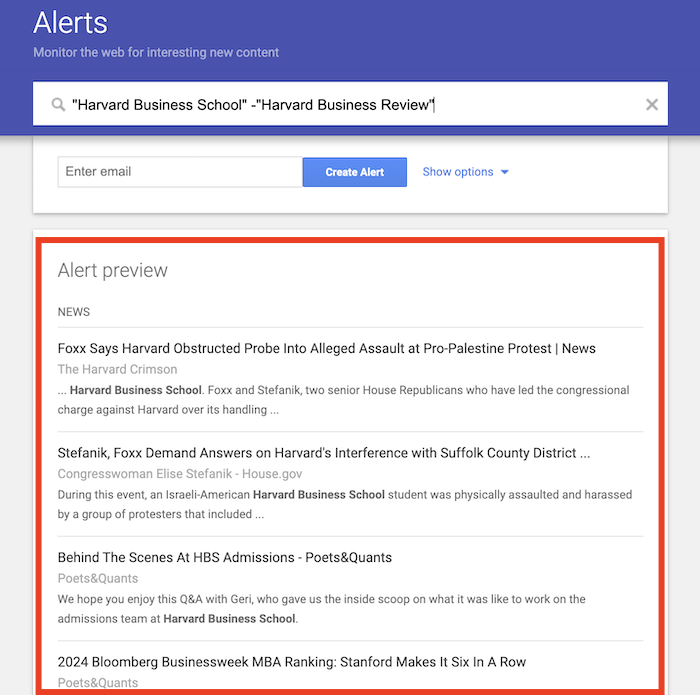
Editing and Deleting Alerts
The best way to edit or delete an alert you’ve set up is to click on the link at the bottom of the email you are sent:
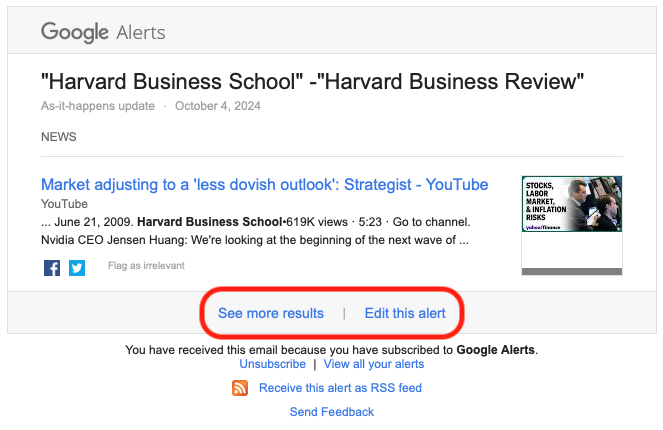
You’ll see a link called “See more results” which takes you to a list of all alerts you’ve set up, with the option to edit or delete any of them. Clicking “Edit this alert” at the bottom of the email takes you directly to the settings for that particular alert, which you can then adjust.
Drawbacks of Google Alerts
Truthfully, there are many drawbacks of Google Alerts. (Hey, did we mention it’s a free tool?) Mostly, people have questions about whether it actually picks up everything. It does not. In fact, PR pros have reported receiving many more results from their paid monitoring tools.
However, if you want only quality results, it does a pretty good job. Honestly, even Google Alerts carry a lot of results that I don’t care about. I’m not sure I would want twice as many from a paid tool.
The other big drawback is that you don’t get social media mentions from Google Alerts, which is a feature of many paid tools.
Google Alerts doesn’t allow for easy reporting. There are no dashboards and instant graphs like you’ll find in the paid tools. It won’t show you the trend in your media mentions over time, or share of voice.
When it comes time to report, you’ll have to curate mentions and transfer them to a spreadsheet if you want to do any sort of data analysis.
Talkwalker
Talkwalker is a paid social listening tool owned by Hootsuite that also offers a basic alerts tool for free as an alternative to Google Alerts. It’s not their primary product, it’s just a magnet to draw people to their website who might one day pay for the full tool. But in the meantime, it’s at least as useful as Google Alerts.
The process is not too different.
How to Set Up Talkwalker Alerts
Step 1: Go to talkwalker.com/alerts and look for the button that says “Create Your Free Alerts!”
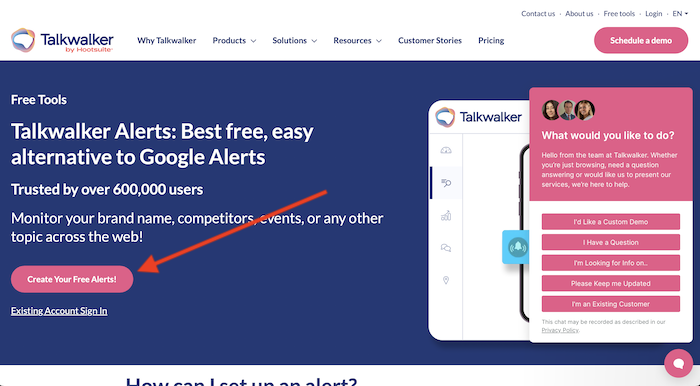
You’ll see some setup fields that look a lot like the Google Alerts version. There are a few key differences.
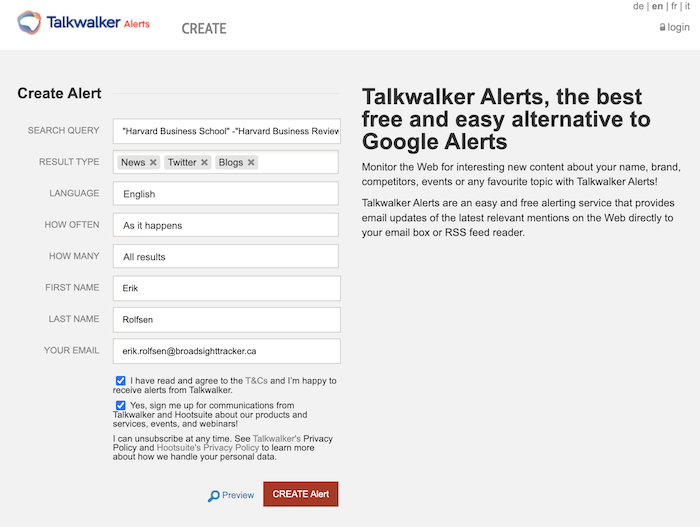
Step 2: Be smart about your search query, just as you would in Google Alerts. I used the same approach of removing “Harvard Business Review” from my results.
If you want to fine-tune the search before you create the alert, you’ll see a small Preview link with a magnifying glass icon to the left of the CREATE Alert button. If you click on that, your results will flow into the column on the right side of the page and you can see if you’re getting what you want.
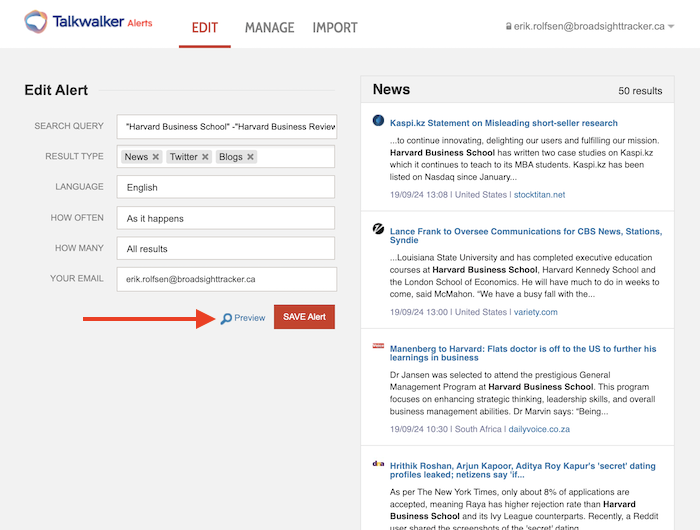
Once you’ve received a few emails, you can also come in and edit the alert to fine-tune what you’re getting.
Step 3: Talkwalker’s Result Type field allows you to select News, Twitter, Blogs or Discussions. Here I am selecting News, Twitter and Blogs.
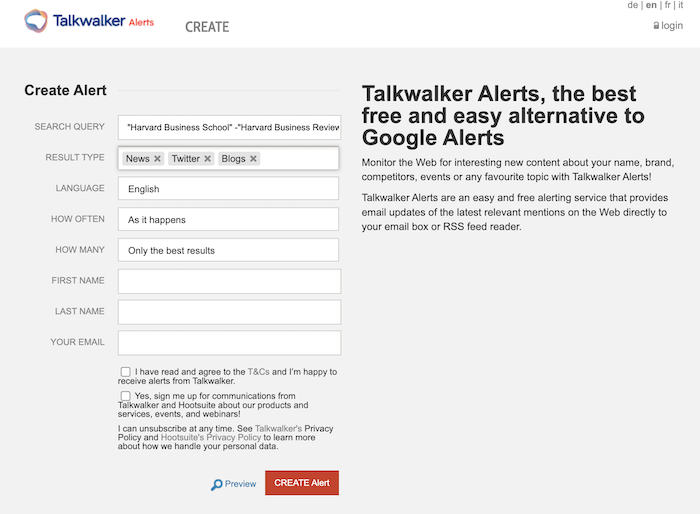
Step 4: The How Often and How Many fields are essentially the same as they are in Google.
Step 5: Then you enter your first name, last name and the email where you want to receive the alerts, tick their required boxes and hit CREATE Alert.
You can create new alerts at any time by clicking on the red CREATE Alerts button in the top right corner, or clicking on the CREATE tab on the top navigation menu. The MANAGE tab is also located on this menu. That’s where you can see all the alerts you’ve set up and edit whichever ones you like.
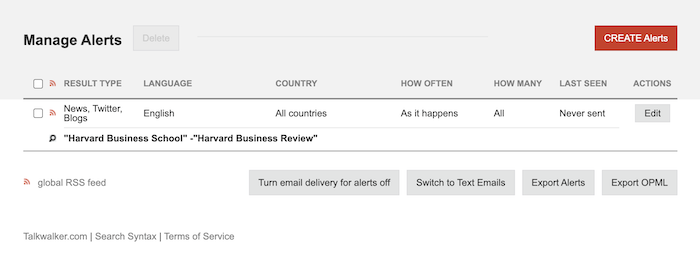
Editing and Deleting Alerts
Editing or deleting an alert is straightforward. Head to the page described in the paragraph above. To edit an alert, click the Edit button to the right of the alert. To delete it, click the checkbox to the left of the alert and then click the Delete button at the top of the table.
Other Talkwalker Alerts Features
Talkwalker lets you turn off email delivery with one click of a button on the MANAGE tab. If you turn this off, you can still access your alerts by RSS feed if you use an RSS reader. You can turn your emails back on again at any time.
If you don’t like all the HTML and graphics on your emails, you can also click a button on this page to switch them to plain text.
Drawbacks of Talkwalker
Talkwalker’s drawbacks are similar to those of Google Alerts. It’s a bit of a mystery as to why it picks up some mentions and not others. I received too many irrelevant results for my liking, but it does seem to find the most important ones.
The free version of Talkwalker has the same flaws as Google Alerts: no social media listening or easy reporting and analytics tools. Free Talkwalker alerts are intended as a gateway into their paid tool, which has these features.
Which is Better?
I ran exactly the same News search on Google Alerts and Talkwalker over two 24-hour periods to see how they differed.
Google Alerts Email
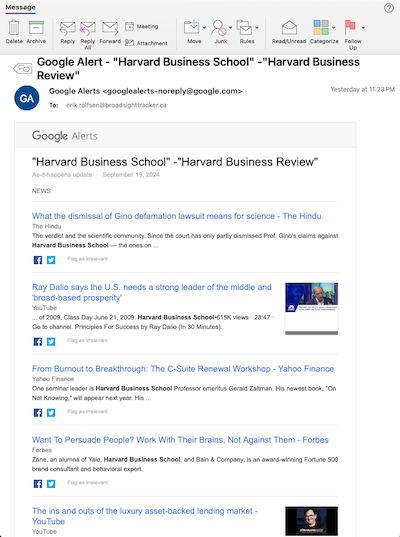
Talkwalker Alerts Email
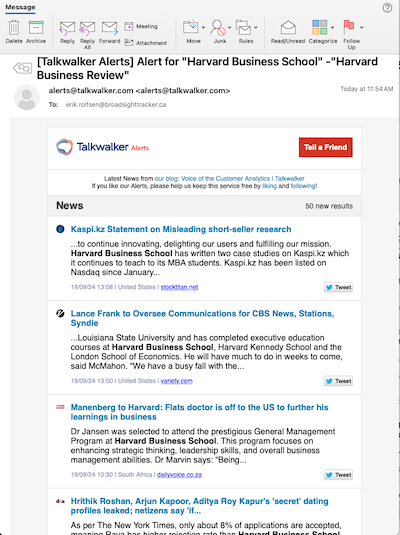
After disregarding syndicated results where identical content turned up from several sources, here’s what I found:
First Test
- Only seven items were picked up by both sources.
- TalkWalker found 26 results that were not captured by Google.
- Google found 23 results that were not captured by Talkwalker.
Second Test
- Only nine items were picked up by both sources.
- Talkwalker found 26 results that were not captured by Google.
- Google found 18 results that were not captured by Talkwalker.
Both alerts were set to As It Happens, but I got six emails from Talkwalker in a 24-hour period and only one from Google Alerts.
Two YouTube videos showed up in my Google Alerts, which was unexpected given that I had not selected “Video” as one of my sources.
I received a lot of syndicated results on Talkwalker, which I ignored in my count. I also got some job postings, which I wouldn’t want or expect from this search. And I got some pages from the Harvard Business School website, which really doesn’t belong in a News search.
Ultimately, if I had to choose between Google Alerts and Talkwalker, I would probably choose Google Alerts.
Talkwalker has a few things going for it. It’s a little more intuitive to set up, and has extra features such as pausing email delivery. It delivers several emails per day on the “As it happens” setting, which Google does not. It also found more results than Google in my testing.
However, I found Google’s results to be slightly more relevant, with fewer mentions that I really didn’t care about. Also, I don’t really want to receive four or five alerts emails during the day. Once a day is fine for my monitoring purposes, so Google’s once-a-day setting gets the job done.
What I Would Do
The wide disparity in results between the two tools was striking, but that tells me something: The results that are picked up by only one tool and not the other are probably not quality results. The results I’m interested in are those that are picked up by both tools. I think you can be assured that these are quality results.
If I had to choose just one, I would choose Google, but the best approach may be to run both alert tools and save only those items that are picked up by both. This will give you fewer results, but they are likely to be the strongest media mentions.
Receive our newsletter
Sign up below and we’ll be in touch with monthly updates about Broadsight, along with news and insights to keep you on the cutting edge of communications work in an AI era.

